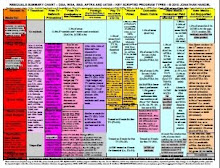The directors guild (DGA) and writers guild (WGA) are meeting soon to discuss new media. That's a hopeful sign, but does it mean the WGA leadership is likely to support the new media deal that the DGA and studios ultimately agree to? Maybe not, for several reasons.
First, as I've previously discussed, the WGA leadership may be subjected to scathing criticism if it looks at the DGA's deal and simply says, "yes, I'll have one of those too." (See WGA Strike: How to Restart the Talks, And Why, section entitled "Why It's Important to Do a Deal Before the DGA Does"). Rightly or wrongly, people will question whether a bruising strike was necessary at all; why not simply have worked without a contract for a few months instead, and let the DGA do their deal?
Second, the DGA places less emphasis on residuals than the WGA or SAG do (see sec. (1) of Writers' Strike: Why They're Talking). This means that the DGA will probably emphasize other issues, such as compensation minimums, somewhat at the expense of new media residuals, in the eyes of the other WGA and screen actors guild (SAG).
Third, each new media residual dollar that the DGA obtains will cost the studios more than twelve dollars. That's because, if the DGA deal on new media residuals serves as a template, the studios would have to pay corresponding amounts to the other unions: in other words, $1 to the DGA means also paying $1 to the WGA, $3 to SAG (there's a 3x multiplier), $4.50 (a 4.5x multiplier) to the IA (the IATSE, which is the union that represents technicians and craftspeople), and around $3 (another 3x multiplier) to the AF of M (musicians union). See Reflections on Residuals: Go Forth and Multiply for discussion of this phenomenon, called pattern bargaining.
Those multipliers are definitely a problem, because they create a wedge that the AMPTP (studio negotiators) can exploit between the DGA and the other two unions. For instance, suppose the DGA were to say to the AMPTP during negotiations "give us $10 more in new media residuals, and, by the way, we know the WGA would probably be happy with this amount too." Sounds nice. However, the AMPTP would look at this proposal and realize that the actual cost to the studios would be more than $120, because of those multipliers.
In response, the AMPTP might say, "no way, but we'll instead give you $50 in additional minimum compensation" (the money that gets paid to a director upfront). In that scenario, the DGA gets more than it asked for ($50 rather than $10), but the other guilds and unions get nothing, because minimums are not mirrored across the various guild and union agreements.
In other words, there's no pattern bargaining, and no multiplier effect, when it comes to minimums or other non-residuals issues. Thus, the AMPTP is more willing to give a dollar on a non-residual issue than on residuals. And - as mentioned above - those non-residual issues are precisely the ones that are somewhat more important to the DGA anyway.
So, the DGA might well accept the AMPTP counteroffer, since $50 is a lot more than $10. Now, that's no criticism of the DGA. Its duty is to represent its members. And, of course, the DGA are not pushovers, and they come to the table armed with almost $2 million worth of research on new media issues, plus a veteran entertainment lawyer, Ken Ziffren, as a consultant. But this "wedge issue" does create a problem when it comes time to sell the new media deal to the other two guilds.
The resolution to this problem has less to do with math and more to do with words: if there are no words on the page, there's nothing to direct. And if there are no actors to speak those words, there's still nothing to direct. Nothing to direct means no work for the DGA member. So, the DGA will need to balance its members' on-paper financial interest with the real-world scenario of one or even both of its sister guilds on strike.
At the end of the day, the DGA and the AMPTP will reach a compromise that, hopefully, incorporates the interests of the other two guilds indirectly as well. In our example, perhaps the DGA and AMPTP would agree on a $5 increase in new media residuals plus a $15 increase in DGA minimums. That would be a $20 total increase for the DGA (better than $10, though worse than $50), a $5 increase for the WGA (better than nothing, but not as good as $10), and corresponding increases for the other guilds in accordance with those multipliers. The cost to the AMPTP would be $75 ($5 times twelve, plus $15), which is not as costly as $120 but is more so than $50.
The key, then, is for the DGA - as well as the AMPTP - to believe that the WGA is serious about the strike, and willing to stay out for months no matter what the loss of income to writers, directors or others (actors, IA, and everyone else). That's a brutal truth, but with direct talks between the WGA and AMPTP stalled, keeping the DGA under pressure may be the WGA's only option.
This article was first published on the Huffington Post on December 18, 2007.

